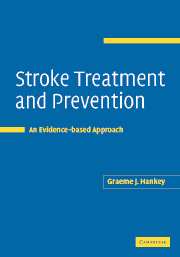Book contents
- Frontmatter
- Contents
- Preface
- 1 The size of the problem of stroke
- 2 Understanding evidence
- 3 Organised acute stroke care
- 4 General supportive acute stroke care
- 5 Reperfusion of ischaemic brain by thrombolysis
- 6 Augmentation of cerebral blood flow: fibrinogen-depleting agents, haemodilution and pentoxifylline
- 7 Neuroprotection
- 8 Treatment of brain oedema
- 9 Anticoagulation
- 10 Antiplatelet therapy
- 11 Carotid artery revascularisation
- 12 Lowering blood pressure
- 13 Lowering blood cholesterol concentrations
- 14 Modification of other vascular risk factors and lifestyle
- 15 Antithrombotic therapy for preventing recurrent cardiogenic embolism
- 16 Arterial dissection and arteritis
- 17 Treatment of intracerebral haemorrhage
- 18 Treatment of subarachnoid haemorrhage
- References
- Index
9 - Anticoagulation
Published online by Cambridge University Press: 23 December 2009
- Frontmatter
- Contents
- Preface
- 1 The size of the problem of stroke
- 2 Understanding evidence
- 3 Organised acute stroke care
- 4 General supportive acute stroke care
- 5 Reperfusion of ischaemic brain by thrombolysis
- 6 Augmentation of cerebral blood flow: fibrinogen-depleting agents, haemodilution and pentoxifylline
- 7 Neuroprotection
- 8 Treatment of brain oedema
- 9 Anticoagulation
- 10 Antiplatelet therapy
- 11 Carotid artery revascularisation
- 12 Lowering blood pressure
- 13 Lowering blood cholesterol concentrations
- 14 Modification of other vascular risk factors and lifestyle
- 15 Antithrombotic therapy for preventing recurrent cardiogenic embolism
- 16 Arterial dissection and arteritis
- 17 Treatment of intracerebral haemorrhage
- 18 Treatment of subarachnoid haemorrhage
- References
- Index
Summary
The purpose of anticoagulation in patients with ischaemic stroke is to prevent recurrent ischaemic stroke and other serious vascular events (by preventing arterial thromboembolism and cardiogenic embolism) and to prevent venous thromboembolism.
Recurrent stroke
The risk of a recurrent stroke after ischaemic stroke or transient ischaemic attack (TIA) is about 10% within 1 week and 18% within the first 3 months in the community (Lovett et al., 2003; Coull et al., 2004; Hankey, 2005). This substantial early risk is 3-fold higher if the TIA or ischaemic stroke is caused by large artery disease, and 5-fold lower if the cause is small artery disease (Lovett et al., 2004). The prevalence and level of other causal vascular risk factors also influence risk of recurrence (Hankey et al., 1992; Kernan et al., 2000; Dippel et al., 2004).
About 50% of all recurrent ischaemic strokes and TIAs are probably due to atherothrombotic disease of the extracranial, or less commonly large intracranial arteries; about 20% arise from emboli from the heart; and about 25% are so-called lacunar infarcts, probably due to occlusion of one of the small, deep, perforating cerebral arteries (Warlow et al., 2000).
The formation of thrombus on the subendothelial tissue of arteries (aorta and large extra- and intracranial arteries) and irregular endothelial surfaces of the cardiac and valvular endocardium depends on the initial formation of a platelet plug (by means of platelet adhesion, activation and aggregation) and the generation of a meshwork of fibrin (by means of the coagulation cascade).
Theoretically, anticoagulants and antiplatelet drugs should be effective in preventing recurrent ischaemic stroke, provided they can both be administered safely over a long period of time.
- Type
- Chapter
- Information
- Stroke Treatment and PreventionAn Evidence-based Approach, pp. 168 - 197Publisher: Cambridge University PressPrint publication year: 2005



